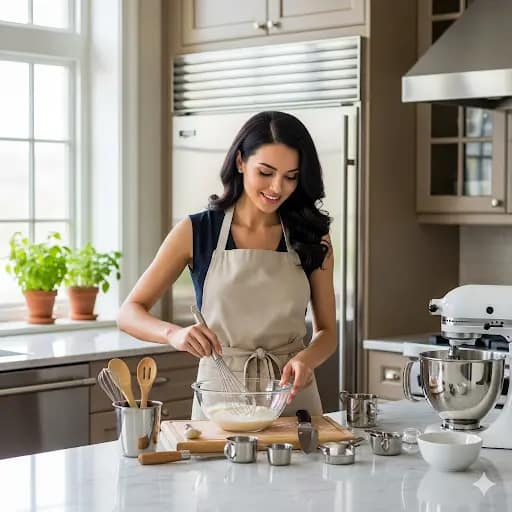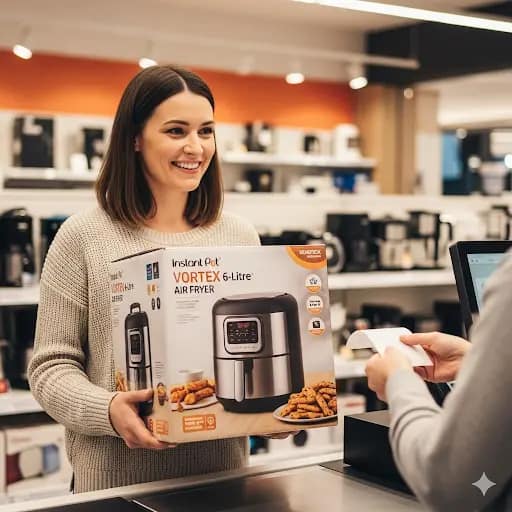Why Smarter Kitchens tools Matter
Cooking for an Indian home can be deeply satisfying—and deeply time-consuming. Between chopping onions, prepping veggies, kneading dough, brewing chai, and cleaning up, it’s easy to spend an hour before the real cooking begins. I’ve been there: tearing up over onions, babysitting boiling milk, scraping stuck batter from bowls, and kneading atta after a long day at work. Then I started testing simple, well-chosen tools that promised faster prep and easier cooking. The difference was dramatic. Tasks that felt like a slog suddenly took minutes, not half an hour..
Over the last few months I shortlisted seven gadgets from Amazon India that consistently reduced friction in my routine. This list isn’t about gimmicky appliances that live in a drawer. It’s about affordable, durable tools that make Indian cooking—rotis, dals, sabzis, snacks—faster, cleaner, and more consistent. Below, you’ll find clear descriptions, honest pros/cons, and practical reasons to consider each pick, so you can buy with confidence and actually use what you purchase.
This article isn’t about gimmicks. It’s about 7 tried-and-tested kitchen tools that deliver real convenience for everyday Indian cooking. Each product here has been reviewed with genuine pros, cons, and reasons why you should consider it—so you can buy with confidence.
Why Trust These Recommendations?
I review products with a focus on practical use in Indian kitchens—where curries, chapatis, rice, and tea are made daily. Every tool on this list has been rated on:
- Time saved per task (chopping, boiling, kneading, grilling)
- Ease of cleaning and storage (because convenience should extend beyond cooking)
- Durability after repeated use (including multiple wash cycles)
- Value for money (affordable for most households, generally under ₹3,000)
These reviews are unbiased, with no sponsorships or paid placements—just clear, hands-on observations to help you skip the guesswork.
The 7 Must-Have Kitchen Tools
Below is my curated list of seven kitchen tools I’ve tested in a real Indian home—chosen because they genuinely cut prep time, clean up fast, and survive daily use. You’ll find practical staples (not gimmicks): a grill pan, mini chopper, mandoline slicer, atta kneader, silicone utensil set, travel kettle, and a digital scale. Each review is short and useful—Description ▸ Pros ▸ Cons ▸ Why you can consider this—so you can scan, decide, and buy confidently. Prices and availability shift on Amazon, so use the “Check current price” buttons for live deals. Pro tip: start with one or two high-impact upgrades (mini chopper + silicone tools), then add bigger helpers (atta kneader) if rotis are daily at your place.
1) AGARO Imperial Aluminium Induction-Compatible Non-Stick Grill Pan
About This item
A sturdy non-stick grill pan that delivers quick sears and defined grill marks on paneer, veggie skewers, sandwiches and kebabs. The aluminium body preheats fast on gas and induction, while raised ridges lift food so fat drains and edges crisp. The cooking area comfortably fits two toasted sandwiches or ~250–300 g paneer—perfect for low-oil weeknight snacks.
Pros
- Fast, even preheat on gas + induction
- Defined grill ridges for char lines without oil pooling
- Low-oil cooking: paneer/corn tikka, zucchini, capsicum, sandwiches
- Easy wipe-clean surface; food releases without scraping
- Lightweight & compact for small kitchens
Cons
- No metal utensils (use silicone/wood)
- Best at medium heat; very high flames shorten coating life
- Grooves trap masala; corners need an extra wipe
- No lid if you like steam-finishing
Why you can consider this
Want grilled flavour without buying a big appliance? This pan speeds up snack nights, supports low-oil cooking, and cleans in a minute—great for students, small families, and busy weekdays.
2) HealthSense Chef-Mate KS-63 Digital Kitchen Scale
About this item
A slim, accurate scale that simplifies baking, macros, and consistent recipes. Tare zeros containers instantly; flat platform wipes clean. Weighs everything from whole spices to bulk flour so cakes, rotis, and portions stay predictable.
Pros
- Precise reads for baking and diet plans
- Tare + quick display for speed
- Lightweight, compact; easy storage
- AAA batteries last long, easy to replace
Cons
- Not waterproof—wipe, don’t wash
- Ultra-light bowls can slide—use a plate/mat
- Needs periodic battery change
Why you can consider this
Removes guesswork—200 g flour or 20 g nuts on point every time. Perfect for bakers and anyone tracking portions.
3) Clearline Automatic Electric Atta Dough Kneader – Stainless Bowl
About this item
A dedicated kneader that mixes and kneads chapati/paratha dough in minutes—no sticky hands, no uneven texture. Stainless bowl + dough hook handle daily family needs (about dough for ~8–10 rotis per batch) with uniform results.
Pros
- Hands-free, consistent dough
- Real time-saver for daily rotis
- Stainless bowl cleans well, feels sturdy
- Hygienic; less counter mess
Cons
- Bulky for tiny countertops
- Parts need rinsing right after use
- Needs a nearby power socket
Why you can consider this
If rotis are routine, this brings predictable texture, less effort, and quicker clean-up—worth it within weeks.
4) Amazon Brand – Solimo 15-in-1 Stainless Multipurpose Slicer/Grater
About this item
A compact kit with interchangeable blades for thin/thick slices, juliennes, grates—great for cucumbers, potatoes, carrots, beets, cheese and paneer. Includes anti-slip base and pusher guard; blade box keeps storage tidy and safe.
Pros
- Multiple cuts from one tool (chips, salads, sabzi prep)
- Stainless blades slice cleanly and uniformly
- Anti-slip board improves safety
- Blade storage reduces clutter/accidents
Cons
- Very sharp—always use the guard
- Not ideal for overripe/very soft produce
- Needs a quick rinse after masala work
Why you can consider this
Uniform slicing speeds prep and elevates presentation. Ideal if you love salads, chips, or neat sabzi—batch work gets fast and tidy.
5) AGARO Silicone Seamless Non-Stick Cookware Tool Set
About this item
A cast-aluminium fry pan with a granite-finish non-stick coating and a glass lid, built for everyday Indian cooking—omelettes, stir-fries, paneer, and light fish fry. The Imperial series is gas & induction compatible, and this popular variant is 24 cm / ~1.6 L (sizes vary by listing). The flat, wide base heats quickly and cleans up with a simple wipe
Pros
- Fast, even preheat thanks to the cast-aluminium body—great for weekday meals. Agaro
- Granite non-stick surface for easy release and quicker clean-up.
- Glass lid included for simmering and splash control.
- Induction + gas compatible base for flexible use.
- Handy everyday size (~24 cm / 1.6 L) for 2–3 servings (omelettes, bhurji, sautéed veg).
Cons
- Non-stick care required: avoid metal utensils; use silicone/wood to protect the coating (hand-wash recommended). (General non-stick best practice)
- Not for very high-heat searing (keep to low–medium heat for coating life). (General non-stick best practice)
- Capacity varies by variant (some listings show 20 cm/1.1 L or 28 cm/3 L—double-check size before purchase).
Why you can consider this
You want a daily-driver fry pan that heats fast, works on both induction and gas, and cleans in a minute. This Imperial Granite fry pan hits that sweet spot for small families and students—reliable non-stick, a practical glass lid, and a size that handles most weekday cooking without hogging storage
Tip: If you need a smaller or larger capacity, the Imperial range includes 20 cm (~1.1 L) and 28 cm (~3 L) options—pick based on your typical portions.
6) Hydroboil Lite Electric Portable Kettle/Heating Bottle
About this item
A travel-friendly heating bottle for boiling water, tea/coffee, and instant meals on the go. Compact enough for backpacks/office drawers; many variants have auto cut-off. Cleaner and safer than juggling pans on hostel hotplates.
Pros
- Fast boil for quick beverages/noodles
- Compact & lightweight; truly portable
- Often includes auto-shutoff
- Saves LPG for simple heating tasks
Cons
- Small capacity vs full kettles (single-serve)
- Descale regularly in hard-water areas
- Liquid-only—avoid thick soups
Why you can consider this
Perfect for travellers, students, or shared kitchens—hot water/tea anytime with minimal space and fuss.
7) Pigeon by Stovekraft Handy Mini Chopper – 400 ml, 3-Blade
About this item
A pull-string chopper for onions, tomatoes, garlic, ginger, herbs and small nuts. Triple-blade design chops evenly; 400 ml bowl suits quick tadkas, sandwich fillings, and prep for 2–3 servings.
Pros
- Seconds-fast chopping; huge daily time saver
- No electricity; simple, durable mechanism
- Easy to clean; minimal parts
- Compact—lives on the counter
Cons
- Small batches only; don’t overfill
- Pulse for uniform pieces (long pulls puree)
- Pre-cut very hard chunks
Why you can consider this
The cheapest minutes-back tool for everyday Indian cooking. It blitzes tedious chopping and keeps prep calm and clean.
Essential Buying Tips
Choosing kitchen tools that truly help means thinking beyond looks and discounts. The best purchases fit your cooking style, survive frequent use, and clean up quickly—so you actually reach for them every day. Before you order, use this checklist:
- Material Quality: Food-grade stainless steel, BPA-free plastic, or high-grade silicone.
- Ease of Cleaning: Dishwasher-safe or simple hand-wash beats fussy parts.
- Storage Needs: Compact tools fit better in smaller kitchens; look for nesting/stacking.
- Brand Reputation: Trusted brands make spares and warranties easier.
- Built for Indian Cooking: Must handle spices, oil, heat, and frequent use.

Final Recommendations
If you’re starting from scratch, begin with the Pigeon Handy Mini Chopper and the AGARO Silicone kitchen Tools Set—two small upgrades that have a big daily impact. If rotis are a staple, the Clearline Atta Kneader pays for itself in time and effort saved within weeks. For variety and healthier snacking, the AGARO Grill Pan plus the Solimo 15-in-1 Slicer bring speed and presentation to weekday dinners. Round it out with the HealthSense KS-63 Scale for better baking and portion control, and the Hydroboil Lite kettle if you travel or work from co-working spaces.
Most importantly, buy for your routine. If you chop daily, get the chopper first. If you love grilled snacks, the pan is the immediate win. Add one tool at a time, use it for a fortnight, and then decide the next upgrade. That’s how you build a smarter kitchen—without wasting money or space.
FAQs
Which tool saves the most time daily?
For most Indian kitchens, the pull-string chopper and the atta kneader save the biggest chunk of prep time—together they can shave 15–25 minutes off a dinner routine.
Are these tools dishwasher safe?
Silicone tools and many slicer parts usually are. Electric items are not—wipe them down. Always check the product page for the exact care label.
How do I stop a grill pan’s coating from wearing out?
Cook on medium heat, use silicone/wooden utensils, avoid aerosol sprays, and let the pan cool before washing. A soft sponge preserves the surface.
Is a digital scale only for bakers?
No. It’s great for portion control, tracking protein/carbs, and replicating family recipes. Precise weighing eliminates guesswork.
Are multipurpose slicers safe?
Yes—with the pusher guard and non-slip base. Keep blades in the storage case, and never let kids use them.
Does an atta kneader work for small quantities?
Most do fine with everyday family dough. For tiny batches (2–3 rotis), hand-kneading may be quicker; for 6+ rotis, the kneader shines.
Can a portable kettle handle milk?
Some can, but milk scorches easily. Use water by default; for milk, supervise closely and clean immediately to prevent residue.
Do silicone spatulas absorb smells?
If left oily, yes. Wash promptly with warm soapy water; a bit of baking soda removes strong masala odors.
Will a grill pan replace my tawa?
No—it complements it. Use tawa for rotis/dosas; grill pan for sandwiches, paneer, veggies, tikkas—especially low-oil, quick snacks.
How long will these tools last?
With gentle care: silicone tools 2–3 years, grill pans 1–2 years of regular use, slicer blades longer if stored dry; electrics often longer with maintenance.
Do I need both a mini chopper and a slicer?
They solve different tasks. Chopper = quick onion/garlic/tomato dicing. Slicer = uniform slices/juliennes for salads, chips, and neat sabzis.
Where should I place them for easy workflows?
Keep the chopper and spatulas on the counter; slicer in the top drawer; grill pan on an easy-reach rack; kettle near a socket; kneader in a base cabinet with open shelf height.










